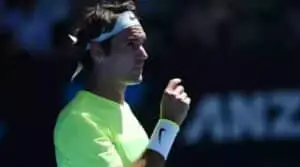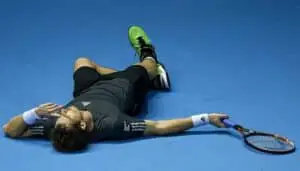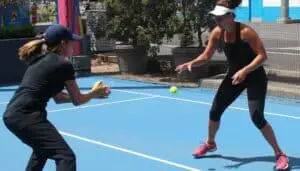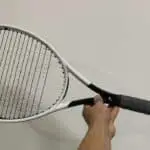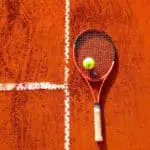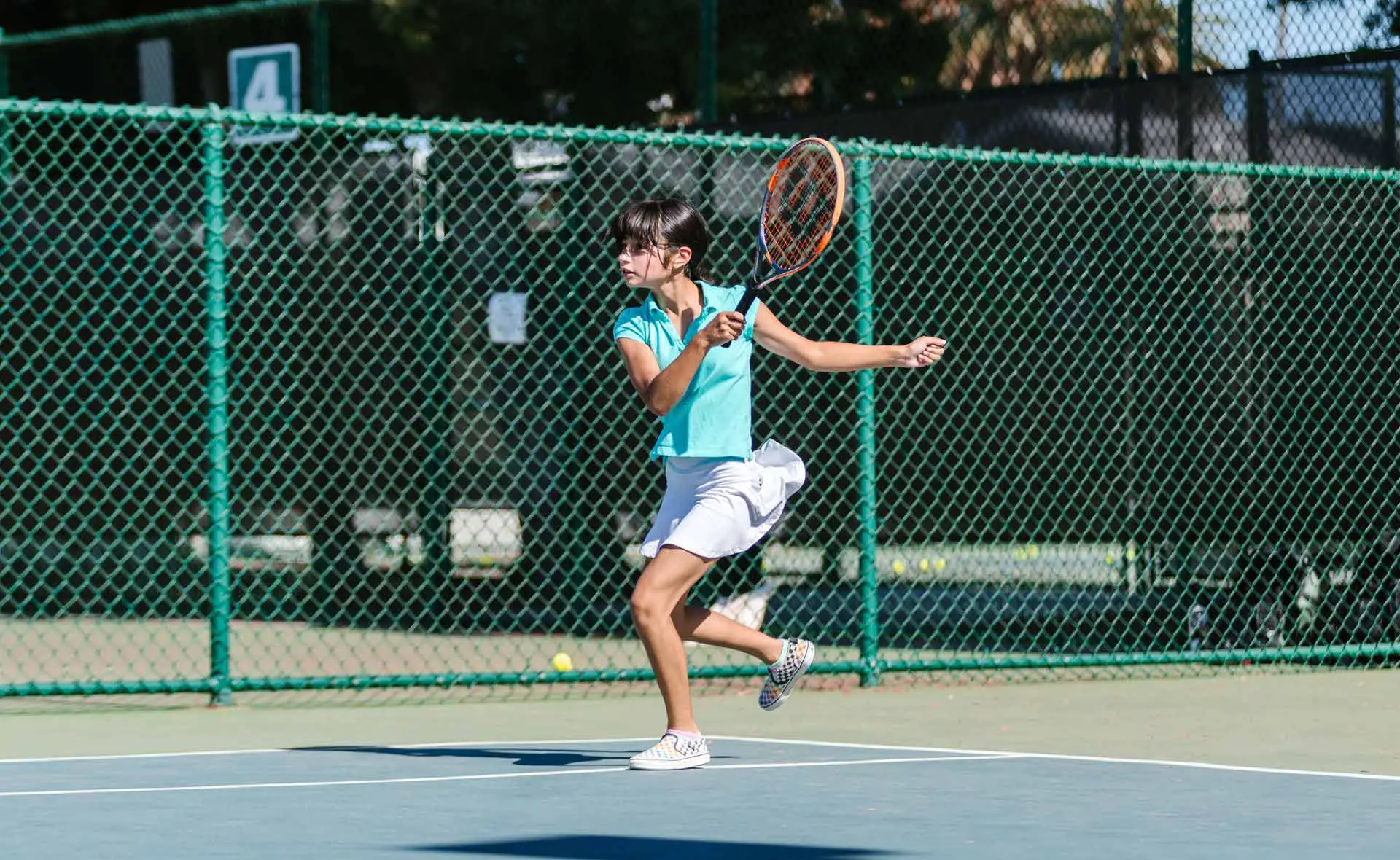
How To Play Tennis For Beginners?
First, congratulations on viewing this post. That means you are interested in learning a new sport, which puts you in a position better than most people. There’s never been a better time to learn how to play tennis.
Whether you are a beginner or an advanced player, tennis is a demanding sport in terms of effort and concentration. Your body must work in total harmony in order to execute the right shot at the right time and have the upper hand in the exchange.
While professionals make tennis look so easy on the TV, it is one of the toughest sports out there and needs quite a steep learning curve to start playing well and enjoy your time on the court.
In this guide, we will walk you through the basic rules, techniques, and tips to make understand the fundamentals of the sport and how to start playing tennis quickly as a beginner.
Seniors are more than welcome since tennis is a sport for all ages.
How to Start Tennis Today?
Find a place to play tennis
To begin with, you need to look for a nearby tennis club. Ask people or simply type ‘tennis club nearby’ in google.
Read Also:
How Much Do Tennis Lessons Cost?
How Much Does it Cost to Rent a Tennis Court?
Choose the right gear
In order to play tennis, you should have the right equipment. We have a guide for this but for now, let’s talk about everything you need to be fully armed and ready to take the court by storm.
So what do you need to get started?
Racquet
In this early stage, don’t overthink the racquet. For example, you can ask your coach to hand you his racquet to test it.
You can also demo a racquet, a service that some online stores offer.
Keep in mind there is a thing called the myth of the perfect racquet. There is no perfect tennis racquet, but just an adequate one that suits your game well, and you can only be certain after weeks or months of playing tennis with that racquet.
For now, let’s keep it simple. Ask your coach to let you test several racquets and based on that buy one.
If you’re a beginner, we recommend a lighter racquet with a big sweet spot like the Babolat Pure Aero, or the Wilson SW102.
Tennis Balls
For a beginner, we recommend playing with used balls. Also ask your coach to bring a bucket of used balls, which makes shots easier to control.
Tennis Shoes
It is strongly advised to use shoes designed specifically for tennis. In fact, they are destined to absorb the shocks, facilitate your footwork and make you slide easily on the court.
Sprains are one of the most common tennis injuries and proper footwear is one way to prevent them. Prices vary depending on the quality of the cushioning, the materials, the outsole, and so on.
Use this guide to choose the best tennis shoe for you. If you’re on a budget, there are solid cheap options for tennis shoes.
Beverage and Food
Tennis requires a lot of energy, so you should bring something to drink and to eat.
Good hydration is essential during tennis, whether recreational or competitive, to avoid fatigue and muscle pain. To do so, bring with you at least:
- Mineral Water: Drink once every 10 minutes. Do not wait until you are thirsty. Drink regularly to keep fit.
If you play tennis for a long time, a moderate food intake can be useful. You can have:
- Banana
- Energetic bar or gel
- Dry Fruits
Please avoid white sugar, which gives an energy spike but leads to more fatigue afterward.
Basic Rules of Tennis
Before taking the step-by-step beginner guide, you need first to understand the rules of tennis.
Scoring rules
Point
A player scores a point when he wins the exchange. The player wins the point if he hits a winner, or if the opponent makes a foul.
The points are counted in the following order:
- First point: 15,
- Second point: 30,
- Third point: 40,
- Fourth point: game.
Game
A game is played until one player has 40. He then needs to score one additional point to win the game.
If the opponent also has 40, we call it a deuce. A player then needs to score two consecutive points to win the game, otherwise, they return to deuce (40-40).
Example 1:
| Player A | Player B |
| 0 | 0 |
| 15 | 0 |
| 15 | 15 |
| 30 | 15 |
| 40 | 15 |
| Wins game |
Example 2:
| Player A | Player B |
| 0 | 0 |
| 15 | 0 |
| 15 | 15 |
| 30 | 15 |
| 40 | 15 |
| 40 | 30 |
| 40 | 40 |
| Advantage | |
| Wins game |
Set
To win a set of tennis, you must win 6 games and have a minimum lead of 2 games over your opponent (6-4 or 7-5 for example).
If the players are at 6-6, a thirteenth game is played to break the tie: it is called tiebreak. In the tiebreak, the points are this time counted from 1 to 7. The first player to reach 7 points wins the set, provided that he has a 2-point lead (e.g. 7-5). If not, the game continues until this lead is achieved (e.g. 12-10).
Match
For women’s tennis, all the matches are played to a best of 3 sets. The first player to win 2 sets wins the match.
For men, it depends.
- If it is a match from one of the four Grand Slams (Australian Open, Roland Garros, Wimbledon, and US Open), it is played to the best of 5 sets. The first player to win 3 sets wins the match.
- If it is a non-Slam match, it is played in a best of 3 format.
Basic tennis rules
In this section, we will discuss the basic rules of tennis that one should abide by to play the game conveniently.
A point starts with a serve

The server is the player who puts the ball into play for the first point. The returner is the player who is about to return the ball served by his opponent.
- The serve must absolutely land in the cross-court service box without touching the net before.
- If the serve touches the net and then lands in the box, it is called a let. In this case, the player replays the first serve.
- If the first serve fails to clear the net or lands anywhere outside the service box, it is called a In this case, the player plays the second serve. He now is in danger of losing the point if he makes a double fault.
- If the returner fails to return the serve, it is called an ace.
Typically, the first serve is struck with full power and skill to take the upper hand in the exchange or to hit an ace. On the other hand, the second serve is conservative and hit with less power to avoid making a double fault.
There are a few exceptions on the court like American Pete Sampras, who used to enjoy serving second with full power to surprise the opponent. Australian Nick Kyrgios does it sometimes as well.
Who starts the match?
The server in the first game is decided by a coin toss before the beginning of the warm-up. Whoever wins the toss chooses whether to serve or return.
The balls stays between the lines
You strike the ball above the net and it should land in the inner sidelines for single players. For doubles, the boundaries are the exterior sidelines
A ball touching the sidelines is considered on the court.


Fouls
You commit a foul in-game when:
- You hit the ball outside of the boundaries we mentioned earlier,
- You hit the ball on the same side as yours.
- Your ball touches a fixed object (other than the net) before it bounces on your opponent’s court.
- You hit the ball before it crosses the net (your racquet is on your opponent’s side)
- You let the ball bounce twice in your court.
- You return the serve before the ball bounces (rarely happens)
- You touch the ball with any part of your body except your racquet.
- You touch the net with any part of your body including your clothes, while the point is still on.
- The ball in-game touches your racquet while not holding it.
A serve foul happens when:
- You serve and touch the baseline with your foot.
- You serve and touch the other side of the serve position.
- You miss the ball
- You serve outside of the box
- The ball touches your body or your teammate’s body in doubles. That includes the clothes as well.
Rule of continuous play
A tennis game has to be continuous from start to finish. Therefore, some rules are implemented:
- The warm-up lasts 5 minutes.
- Between points, the players are allowed a maximum of 20 seconds.
- When players change sides at the end of a game, they are allowed a maximum of ninety 90 seconds.
- After the first game of each set and during a tiebreak game, the play should be continuous and the players have to change sides without rest.
- After each set, the players have 120 seconds to rest.
- If, due to circumstances beyond the player’s control, an equipment (excluding the racket) is damaged or requires replacement, the referee may allow the player an additional time.
- If a player suffers from an injury, he can ask the referee for an MTO (medical time out), which is 3 minutes. The referee can exceed the MTO to a maximum of 15 minutes but only after the third set of a 5 setter match, or after the second set of a 3 setter match.
Importance of Grips in Tennis
Embed from Getty ImagesSemi-western grip by Tomas Berdych
It is useful to know the different types of grips and the usage of each one. Holding the racquet correctly is a crucial part to play good strokes.
When playing tennis, it is not possible to perform all the tennis shots with the same grip.
Therefore, during a rally, the player must frequently change the grip of the racket depending on the shot he/she needs to play.
Common grips in tennis
We can identify the grip with the number of the bevel of the racquet handle, as shown below:


You position your hand according to the line joining the palm side of your index finger knuckle with the opposite carpal bone. The line between 1 and 2 is the one you put on the bevel before gripping tight on the bottom of the racquet handle.
Continental grip
It is defined by bevel n° 1
This is one of the most used grips in a tennis match. This grip allows the players to play different types of shots. The common usage of this grip are:
- Flat serve
- Volley
- Slice
- Forehand and one-handed backhand by a few players
| Pros | Cons |
| Good for low-bouncing balls | No topspin |
| Easy switching to other grips | Bad for high bouncing balls |
Eastern grip
It is defined by bevel n° 3 (right hand) or n° 7 (left hand)
The eastern grip is popular because it is easy for beginners. Nevertheless, many pros use this grip for their forehand such as the great Roger Federer. The common usage for this grip is
- Flat Forehand
- Spin Forehand
| Pros | Cons |
| Easier for beginners | Not enough spin which allows faults |
| Powerful | Needs accuracy |
| Great for serve-volley | Not good for baseline play |
| Quick grip change |
Semi-western grip
It is defined by bevel n° 4 (right hand) or n° 6 (left hand)
It is a very common grip among top players. In fact, this grip is the perfect balance between great topspin and power and quick grip change. The grip provides better control than the eastern grip, which results in fewer faults and longer exchanges.
Moreover, this grip allows the player to play long baseline exchanges and go to the volley often.
Players like Novak Djokovic and Serena Williams use this grip.
The common usage for this grip is:
- Forehand
| Pros | Cons |
| Great topspin | Hard to negotiate low bouncing balls |
| Great for all-court play | |
| Quick grip change | |
| Good for all surfaces |
Western grip
It is defined by bevel n° 5
Many clay players use this grip in order to generate a lot of spin on the ball. The goal is to play conservatively and be powerful. That means the ball will most likely land on the court and be pacier and hard to negotiate by the opponent.
Players like
The common usage for this grip is:
- Top spin Forehand
| Pros | Cons |
| Immense topspin | Uncomfortable grip |
| Perfect for clay courts | Long grip switching |
| Great for baseline play | Difficult to master |
Tennis Strokes
Serve
Embed from Getty ImagesA tennis point starts with one player serving and another returning. You toss the ball high with your non-striking hand above you by 2 to 3 feet and you swing using pronation to brush through the ball. The ball must land in the cross-court service box of the opponent.
Forehand
Embed from Getty ImagesIt is one of the two most known groundstrokes. You should use your dominant hand to swing.
At a high level, the forehand shot is very often a strong arm to make winners. We frequently see players bypass their backhand position to shoot a forehand.
To play a good forehand you will need:
- Good balance: You need a solid stance with legs firmly on the group opened less than the shoulders. Also, you have to bend your knees to control the shots.
- Adequate distance from the ball: You need to make enough room for the swing of your racquet. However, don’t be too far.
- Shoulders orientation: The shoulders should be perpendicular to the net. Once you shoot the forehand they rotate until they are parallel to the net.
- Front striking point: Always make sure to strike the ball in front of you. This allows you to time and control the shot better.
Backhand
Embed from Getty ImagesYou use your backhand shot when the ball arrives at your non-dominant hand. There are two types of backhands commonly used in professional and amateur tennis, the one-handed and the two-handed backhand.
In general, it remains the most difficult shot to master fully by amateurs. When your opponent finds out you don’t have a solid backhand, you would be in a tough position.
Volley
Embed from Getty ImagesA volley happens when you strike the ball before it bounces. It generally takes place near the net to finish a point.
It is usually a great way to win points, especially for players with a big serve.
The volley requires a continental grip and good reflexes.
There are two types:
- Forehand volley
- Backhand volley
These are some tips to play a good tennis volley:
- Keep in a ready position with both hands on the racquet
- Play in a forward motion, anticipate the path of the shot, and jump towards the ball
- Hit gently with a firm grip. Don’t do anything fancy, just cut the trajectory.
- Drive with your non-dominant hand
Slice
Embed from Getty ImagesIt is the opposite of topspin. The spin motion is backward so that the ball stays low and travels longer. The goal is to put the ball near the baseline and make it difficult for your opponent. The common usage of a slice is:
- When you receive a difficult ball and you are in full stretch, you use the slice to return it
- You surprise your opponent with a (Chip and Charge), which is a deep slice followed by a volley on the net
- You use it as a variation after a long baseline exchange to break your opponent’s rhythm and force him to play a low ball
Drop Shot
A drop shot is similar to a slice, except that the racquet is more open to the sky when you hit the ball. This results in a short and higher ball, making it easy to overcome the net and land far from the opponent. It is a fantastic technique to surprise your opponent and win the point.
You hit a drop shot with the continental grip, by either the forehand or the backhand.
Playing Tactics
To play a match of tennis, you need to have a tactic or strategy. If we stop the match and ask you what tactic are you using, you have to answer the question.
Below you will find the basic tactics you can start to implement right away in your game.
Opponent Analysis
The first important task, to begin with, is analyzing the other player game by answering a few questions quickly:
- Is he/she left handed or right handed?
- Does he/she move nicely or badly on court?
- What are the opponent’s strongest shots?
- What are his/her weakness, is the backhand short or is the volley weak?
- Does the opponent play from baseline or go to the net more often?
- Is his/her serve good or bad?
Importance of Shot Variation in Tennis
Variation is a great tactic to surprise your opponent and break his/her momentum. For example, when you cut a long sequence of baseline shots with a slice or a drop shot, the opponent can make a fault and you win the point. These are some great shots variations:
- Effect: Use topspin, slice, and flat shots
- Ball Length: Variate between deep shots and short cross-court shots, or drop shots.
- Ball Height: Shoot low balls and high balls.
- Go to the net: When you destabilize your opponent with an acceleration, finish the point with a volley
- Serve Variation: Variate between flat serve, slice serve and kick serve
- Rhythm: This helps regain some energy and put pressure on the opponent when you sense it.
Play your strengths
A tennis match is not a place to experiment with new tactics. You practice that in training with a coach or a friendly match. However, in a competition, you have to play with your trusted best tactics to win.
To do that, you set up two or three strategies. On the court, you adapt your game according to your opponent and your daily performance. For example, if you are having a bad day with volleys, you switch to baseline play and try to outplay the other player using his weaker shot.
Common Tennis Play Styles
Serve & Volley
Some players like going to the net very often during the match. They have a great volley game and are very quick around the net. In general, these players try to hit winners and finish the points as quickly as possible. Ultimately, this strategy is based on putting pressure on the opponent.
When serving, these players often go to the net immediately after the service to hit the volley.
When not serving, they try the chip and charge with a deep slice followed by a volley on the net.
Example: Pete Sampras, John McEnroe, Martina Navratilova
Baseline Play
A baseliner is a player who likes exchanges from the baseline. He needs to be physically strong to resist the exhaust. We can distinguish two types of baseliners:
- Offensive Baseliner: He wins the points by hitting winners from the back of the court. He needs fast-paced penetrating balls to outplay the opponent. They also use variations like short cross-court balls or topspin shots to break the momentum and find an opening to hit the winning shot. Example: André Agassi, Serena Williams.
- Defensive baseliner: Also known as counter-puncher. This player relies on the opponent making mistakes. This game needs a very low error rate in the shots, and great physical endurance and mental resources. This player can handle long exchanges with baseliners or try to win points by passing shots against volleyers. Example: Rafael Nadal, Chris Evert.
Pure Volley
Some players like to go to the net on every single occasion. They put constant pressure on the opponent during the whole match. This strategy is not a rock star but can be very effective against baseliners. The downside is the amount of passing shots they concede during a match. Example: Misha Zverev, Dustin Brown
All-around Play
It is a perfect mix of the benefits of each playing style.
These players are smart and talented; they have the art of selection and variety in their shot armada.
Mostly, they have good serves and returns. Example: Novak Djokovic, Roger Federer, Steffi Graf.
Final Thoughts
Tennis is a fabulous sport. You can start for as low as $300 and hit a nearby court.
For newbies or children, we highly recommend finding a coach in order to learn the fundamentals.
For beginners, a little familiar with the sport, this article and some videos on the internet can massively improve your game. Long live Tennis!
If you can’t find a partner, we have a guide on how to play tennis by yourself.


